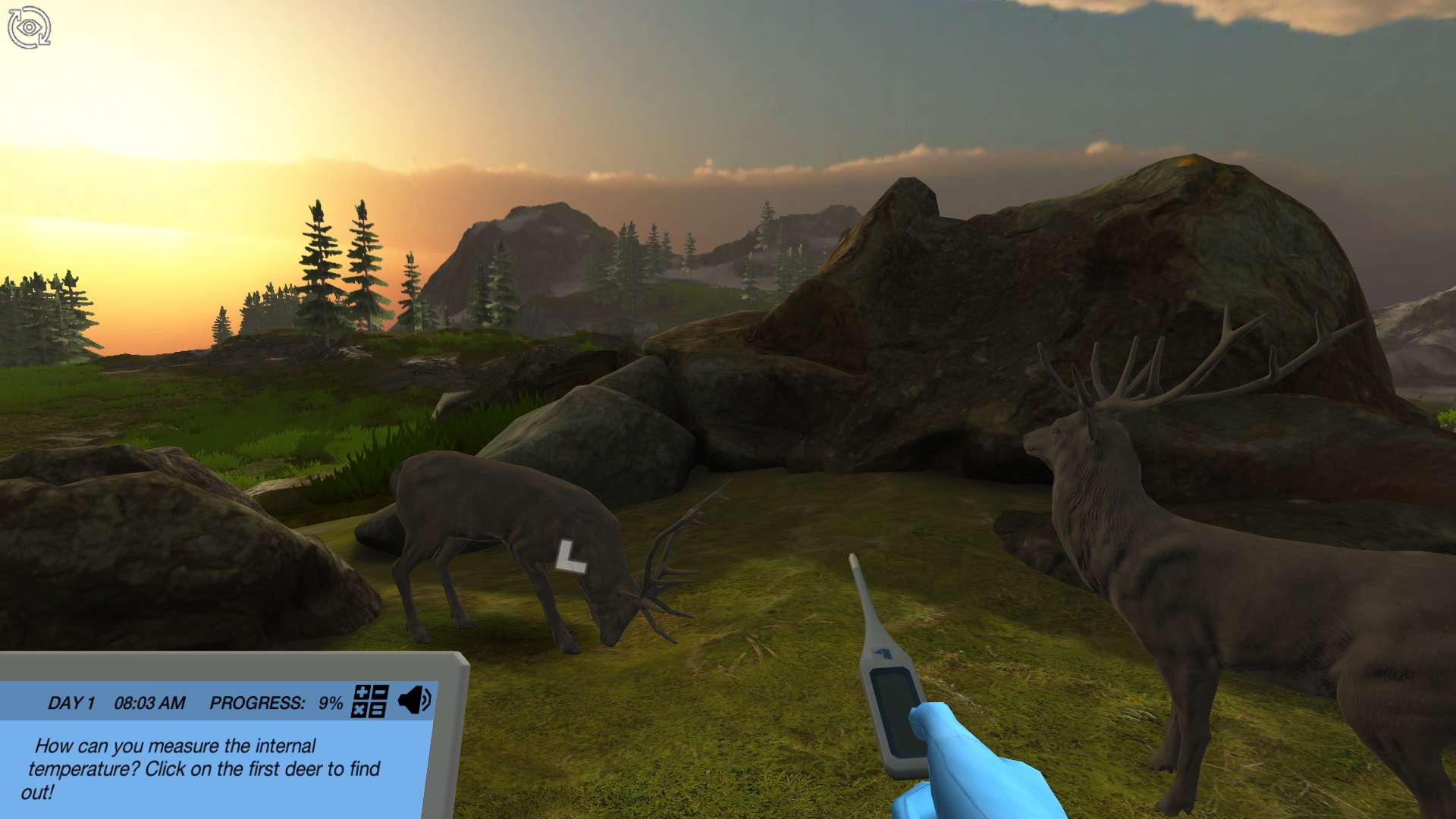Heading 1
Heading 2
Heading 3
Heading 4
Heading 5
Heading 6
Lorem ipsum dolor sit amet, consectetur adipiscing elit, sed do eiusmod tempor incididunt ut labore et dolore magna aliqua. Ut enim ad minim veniam, quis nostrud exercitation ullamco laboris nisi ut aliquip ex ea commodo consequat. Duis aute irure dolor in reprehenderit in voluptate velit esse cillum dolore eu fugiat nulla pariatur.
Block quote
Ordered list
- Item 1
- Item 2
- Item 3
Unordered list
- Item A
- Item B
- Item C
Bold text
Emphasis
Superscript
Subscript
About This Simulation
See how deer physiologically respond to climate change. Use a metabolic chamber and Douglas bag to measure the oxygen content, humidity and volume of a deer’s exhaled breath at different temperatures.
Learning Objectives
- Understand the principles of heat balance and thermoregulation
- Compare mammalian methods of heat gain and heat loss used to regulate body temperature
- Interpret how vasoconstriction and vasodilation contribute to thermoregulation
- Demonstrate how counter-current exchanges regulate extremity temperatures
- Analyze the impact of thermogenic heat production and heat loss on survival capabilities of deer
- Quantify the metabolic rate of deer at different temperatures
- Compare the thermoneutral zones of deer in summer and winter months
About This Simulation
Lab Techniques
- Oxygen analyzer
- Humidity Probe
- Infrared heat detection
- Metabolic Chamber
- Douglas Bag
- Spirometer
Related Standards
- No direct alignment
- No direct alignment
- 6.6 Hormones, homeostasis and reproduction
Learn More About This Simulation
Maintaining a constant body temperature is central to an animal’s survival. In this simulation, you will apply the principles of thermal homeostasis to understand how deer thermoregulate in response to climate change. You will complete field work in Northern Canada and then carry out experiments in the lab on the effect of high temperatures on deer using a metabolic chamber and Douglas bag. You will measure oxygen content, humidity and volume of breath exhaled, and calculate the metabolic rate, evaporative heat loss and fat burned to answer how climate change affects deer in the North.
Help the International Climate Change Committee
The International Climate Change Committee wants you to investigate how large animals in the North are affected by changing temperatures. You will therefore collect internal and external body temperature data of deer in Northern Canada before returning to the lab where you will learn how changes to blood vessels can help deer maintain thermal homeostasis. By calculating and comparing potential heat production to potential heat loss, you will be able to determine how deer can optimally respond to changes in temperature.
Experiment using a metabolic chamber
You will alter the temperature and air flow through a sophisticated metabolic chamber holding a deer. An oxygen analyzer measures the oxygen content of air flowing in and out of the chamber and allows you to calculate and compare the metabolic rate of deer at different temperatures. Using a face mask on the deer attached to a Douglas bag, you will be able to measure the humidity and volume of exhaled air at different temperatures. This allows you to determine which factors change in order to help the deer maintain thermal homeostasis. In this simulation, you can repeat experiments quickly at various temperatures for deer during summer and winter months, with and without wind. An emphasis on unit conversions ensures that you are able to compare your calculations for heat production with heat loss and ultimately with fat burned per day to identify how long deer can survive in Northern conditions.
Summarize thermal homeostasis
Finally, you will summarize everything you have learned about thermal homeostasis by identifying which physiological conditions are increased and decreased during hot and cold days. Will you be able to predict how deer respond to climate change in the North?
Experience Labster for Yourself
Boost Learning with Fun
75% of students show high engagement and improved grades with Labster
Discover Simulations That Match Your Syllabus
Easily bolster your learning objectives with relevant, interactive content
Place Students in the Shoes of Real Scientists
Practice a lab procedure or visualize theory through narrative-driven scenarios


For Science Programs Providing a Learning Advantage
FAQs
Find answers to frequently asked questions.
Heading 1
Heading 2
Heading 3
Heading 4
Heading 5
Heading 6
Lorem ipsum dolor sit amet, consectetur adipiscing elit, sed do eiusmod tempor incididunt ut labore et dolore magna aliqua. Ut enim ad minim veniam, quis nostrud exercitation ullamco laboris nisi ut aliquip ex ea commodo consequat. Duis aute irure dolor in reprehenderit in voluptate velit esse cillum dolore eu fugiat nulla pariatur.
Block quote
Ordered list
- Item 1
- Item 2
- Item 3
Unordered list
- Item A
- Item B
- Item C
Bold text
Emphasis
Superscript
Subscript
Labster can be integrated within a school's LMS (Learning Management System), and students can access it like any other assignment in their LMS. If your Institution does not choose an LMS integration, students will log in to Labster's Course Manager once they have an account created. Your institution will decide the access method during the sales process.
Labster is only available for purchase by faculty and administration at academic institutions. To procure Labster, simply reach out to us on our website. Schedule a demo, book a meeting to discuss pricing, start a free trial, or simply fill out our contact form.
Labster simulations are created by real scientists and designed with unparalleled interactivity. Unlike point and click competitors, Labster simulations immerse students and encourage mastery through active learning.
Labster supports a wide range of courses at the high school and university level across fields in biology, chemistry and physics. Some simulations mimic lab procedures with high fidelity to train foundational skills, while others are meant to bring theory to life through interactive scenarios.

















